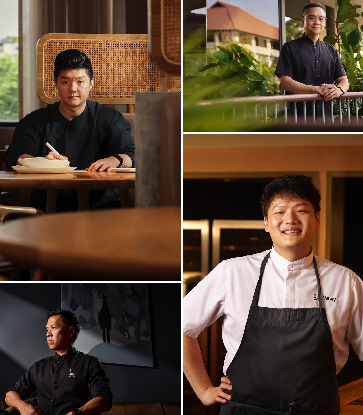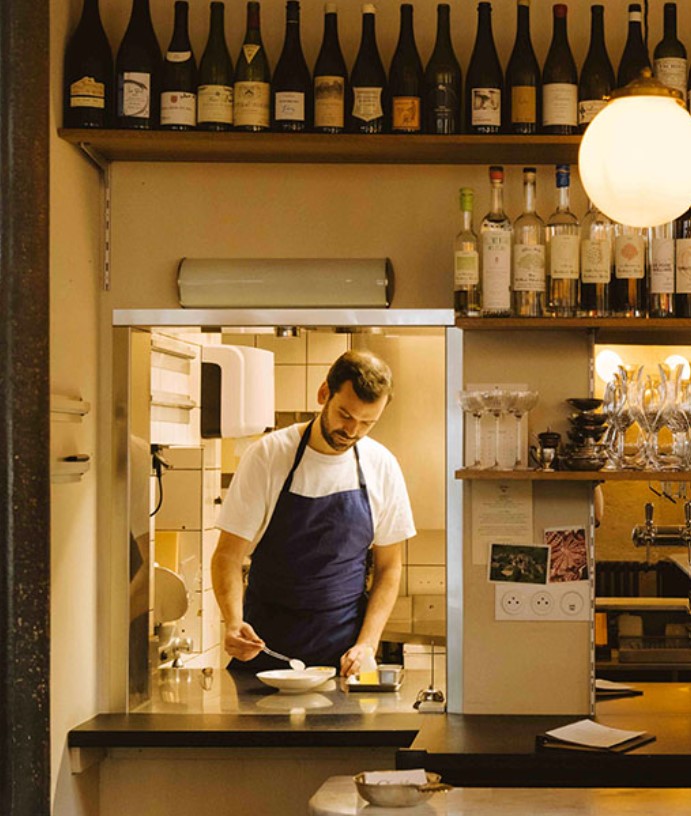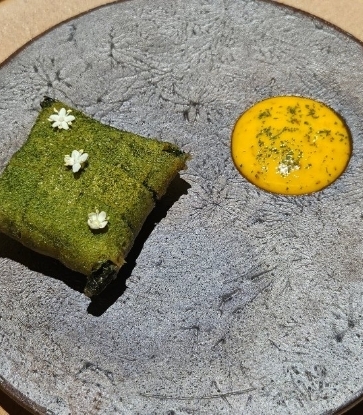Like many other chefs and food enthusiasts, the early days of Malcolm Lee’s culinary journey were defined by a hunger for discovery and novel experiences that have taken his palate beyond the comfort food of his childhood.
There is a Chinese proverb that deeply resonates with Lee, reverberating with his passion to champion heritage cuisine; it goes: "Falling leaves do not stray far from the roots of the tree from which they came from.” Being a Singapore-born Peranakan, Lee grew up enjoying Peranakan home cooking, along with a mix of Cantonese and Hokkien dishes. "They were part of my mother’s culinary repertoire,” says Lee. "As I grow older, I continue to realise that the menus I create in my restaurants are actually grounded in the comfort foods of my childhood, as well as the dishes and flavours that I love to eat the most — rice, curry, and sambals.”

A sense of loss
After receiving a scholarship to attend the At-Sunrice GlobalChef Academy, Lee first entered culinary school in December 2008. “Back then, I really wanted to master the cuisine and techniques that the leading contemporary chefs at that time, such as Heston Blumenthal [of two-MICHELIN-Starred Dinner by Heston Blumenthal], were doing,” says the 37-year-old chef. "Yet, by the time I graduated, I realised that what I needed to do first was to master the cuisine of my heritage — my mother’s cooking.”
“What I have done in the years leading up to today has been about mastering the cuisine of my heritage.”
According to Lee, Singapore is still a very young country. Yet, as being part of the third generation, he already feels a sense of loss with the culture he has grown up with. “There is a feeling that we have missed out or overlooked something,” he emphasises.
“This sense of loss is driving us to retrace our steps to understand what we have missed out on,” says Lee. “It’s building on our attempts to identify a certain style of eating that we can consider as Singaporean. In my first restaurant, Candlenut, my attempt to develop a fusion-influenced and contemporary take on our Singaporean style of dining is the cornerstone of the cuisine there,” he explains.
In the broader Singaporean food landscape, Lee observes old hawkers retiring. “Our grandparents or parents are no longer able to cook because of old age. We’re realising that we’ve lost something. Cooking and eating gave us great comfort during our formative years, but we assumed it would always be there. I believe we failed to pay much attention to it,” he says.

The importance of keeping heritage alive
“In order to innovate, we need to first understand how and why dishes were traditionally prepared,” says Lee. Based on his observations, he says that Singapore’s restaurant sector, and the diners themselves, have evolved. “In the past, diners may have instinctively side-stepped heritage cuisine because they considered it old-fashioned. Today, they are interested in learning more about our heritage and are ready to pay a small premium to do this in a restaurant,” he says.
“Our heritage serves as our source material.”
According to Lee, his identity as a Singaporean is an evolving one. He explains, “I feel that my cuisine — my identity — is an ongoing work in progress. It draws from our shared past — histories, cultures, traditions, and ways of living.”
The cycle of discovery and rediscovery
For Lee, the road to discovery is a never ending one. “The more I discover, the more I realise that I am driven by the need to discover. I need to keep growing and exploring to feed my creativity. Knowing that there is so much more to learn and discover inspires me,” he says.
Lee explains that whenever he develops a dish, he begins by throwing himself into the cycle of rediscovering and discovering the food our grandmothers and grandfathers first created with the knowledge, ingredients, and tools that they had at their disposal at that time. This involves a lot of research, uncovering how a dish was prepared, especially traditional dishes that may have been long-lost or forgotten. An important part of his research is also knowing the purpose of the dish — understanding why it was created in the first place.
The next step, according to Lee, is to challenge himself and his team to consider how this culinary information can be adapted to how people eat today. “Sometimes, we don’t change the recipe at all,” says Lee. “We either present the dish as it was originally intended, or we reimagine it with intention by putting ourselves in our ancestors’ shoes — a combination of curiosity and creativity,” he explains.
“The end goal of this process is to hopefully offer deliciousness and familiarity, even if the dish might be a new discovery for our guests, especially as we explore the cuisine of our region from the perspective of where we are — Singapore, which is a place of confluence.” says Lee.

A coming of age at Pangium
Offering a cuisine christened as “Contemporary Straits”, Lee has just recently opened his second restaurant, Pangium, at the Singapore Botanic Gardens. This concept comes 12 years after Lee opened his first restaurant, one-MICHELIN-Starred Candlenut at Dempsey.
“Pangium represents a coming of age for me. It is very much part of my personal journey as a chef and as a Singaporean.”
Pangium is named after the tree where the buah keluak seed comes from. An iconic ingredient in Peranakan cuisine, buah keluak is also Lee’s favourite ingredient, which makes multiple appearances on the restaurant's menu.
“Our focus on the Pangium is not the seed, but the study of the tree — a living system,” says Lee. “We see what we do at the restaurant as part of a shared, living culture that is rooted in tradition and continues to adapt and evolve as it grows. Innovation is the lifeblood of our culinary culture.”
For Lee, Contemporary Straits is all about a desire to rediscover our heritage. “But this is not a sentimental attempt at preserving or restoring the past,” says Lee. “At Pangium, we ask ourselves how we would approach a dish with the mindset of the people who first created it, but prepare it in the context of today. We hope that present-day diners can hopefully connect with it.”
“The tasting menu at Pangium is designed with the intention of taking guests on a journey that guides them back into the past as well as into the future.”
When asked what dishes on the menu are his favourites, Lee talks about the Ikan Chuan Chuan, a traditional Peranakan deep-fried fish dish served in a tau cheo (fermented soy bean) and ginger sauce. Pangium’s version uses Glacier 51 toothfish, Bentong ginger, tau cheo, lily buds, and young spinach. Another highlight is the Pang Susi, which encases a mixture of Iberico pork cheek, white Kampot pepper, candied winter melon, and roasted coriander seed in a sweet potato bun that resembles a bolo bao (melon bun).

Perhaps it is the main course, the Nasi Ulam (Mixed Herb Rice), which Lee is proudest about. He describes it as a showcase of lesser-known vegetables and herbs that is accompanied by an array of side dishes that explore forgotten recipes and flavours. In the Nasi Ulam, diners can expect a taste of tempoyak (fermented durian) usually served with whole patin fish. Pangium's tempoyak is cooked into a diminutive sambal and is topped off with fried fish. Also part of the Nasi Ulam is a buah keluak sambal with oxtail and serunding daging (beef floss with roasted coconut); an achar (pickle dish) with rose apple, lotus root, starfruit, and guava; and a hand-minced duck satay wrapped in caul fat, glazed with kicap manis, and grilled over charcoal. The Nasi Ulam spread is served with a bowl of sayur lodeh (Indonesian vegetable stew in coconut milk) prepared using Japanese vegetables and an ikan bilis sambal.

Lee also takes pride in Pangium’s spread of kuehs and its main dessert of Sagun (young coconut sorbet). “This traditional snack, harking back to the childhoods of my mother and aunt, is rarely seen today as preparing it requires a labour-intensive process.” The coconut sorbet is prepared using coconut water, flesh, and milk. Accompanying it is a mix of roasted grated coconut, glutinous rice, and a touch of sugar and salt cooked until fragrant, and then ground down to a sand-like texture. “The simplicity of this dessert belies its capacity to be deeply evocative for the people who remember enjoying it as children, and a gentle nudge in igniting conversations that encourage the sharing of memories between generations,” says Lee.
Despite the success of his MICHELIN-Starred post, Lee says that Candlenut and Pangium are not mutually exclusive. “They can certainly co-exist, and I believe that they will mature in their individual ways,” he says.
“I don’t see the launch of Pangium as scaling a peak. I am driven by a personal need to keep learning and discovering new things.”

With its serendipitous location right under the tree it was named after, Pangium continues to be part of Lee’s personal journey of studying the cuisine of his heritage. “I feel very blessed. What may seem like serendipity is really the result of years of sheer blood, sweat, and tears. Like every entrepreneur, I have had my fair share of successes and failures. Every high and low point has been a learning experience,” he adds.
Lee says that the opening of Pangium also marks a milestone. “I believe my mission has broadened. It comes from the conviction you develop through experience. It is not just about my heritage anymore. It’s about our heritage. And it is not just about studying the past. It is about giving ourselves the space to explore how we might have a hand in defining some part of our future also,” he says.
“Just as I push and encourage my team to grow, I want to allow space for my own growth, too. To me, each restaurant is a medium for discovery not only for our guests and for our team, but also for myself, too.”
Pangium's interior photo is by The Ate Group. Header image by CR Tan.






















